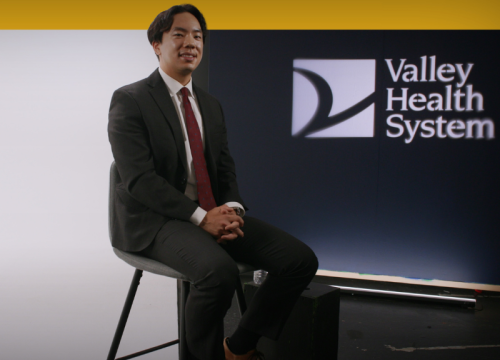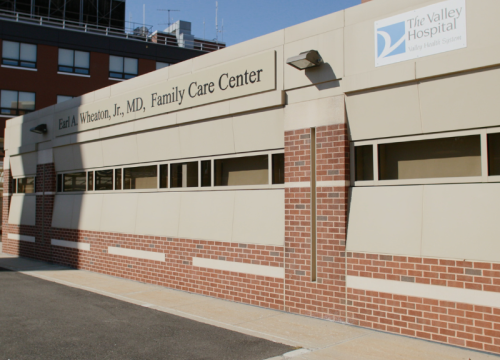Trigeminal neuralgia, also known as tic douloureux, is a condition that causes intense facial pain. It occurs when one of your large cranial nerves (trigeminal nerve) is damaged by an injury, surgery or medical condition.
Even though trigeminal nerve pain can be severe, it can also be treated. At Valley, our neurologists offer nonsurgical and surgical treatment options — including minimally invasive options like Gamma Knife radiosurgery.
Watch: Valley neurosurgeons explain why Gamma Knife can be an ideal treatment option for many people with trigeminal neuralgia.
Trigeminal Neuralgia Symptoms
Anyone can develop trigeminal neuralgia. However, it usually occurs in people over 50 and affects more women than men.
With trigeminal neuralgia, you may experience a stabbing or shock-like feeling in your jaw, teeth, lips, gums or cheek. This pain is often described as an electric shock. It can be triggered by any type of facial stimulation, including:
- Brushing your teeth
- Eating or drinking
- Putting on makeup
- Shaving
- Showering
- Smiling
- Talking
Most people have Type 1 or “classic” trigeminal neuralgia. This means you have episodes of sudden, severe pain that come and go. As your condition worsens these episodes may occur more frequently, with each attack lasting for longer periods of time.
Some people develop Type 2 or “atypical” trigeminal neuralgia. With this type of pain, in addition to the shocks or stabs, you also experience a constant, burning pain that doesn’t go away.
Trigeminal Neuralgia Diagnosis at Valley
Because trigeminal neuralgia is relatively rare — and there isn’t a single, definitive test for it — it’s easy to misdiagnose. Fortunately, Valley’s team has experience identifying this condition. Our doctors are skilled at distinguishing your symptoms from other conditions that cause chronic pain — and making sure you get the right treatments, right away.
To confirm whether you have trigeminal neuralgia, your brain surgeon will perform (or order) one or more of the following:
- A detailed medical history: We’ll discuss how long you’ve had symptoms and how frequently they occur. We’ll also ask you to describe where your pain occurs, what it feels like and what triggers it.
- A physical examination: We’ll lightly touch different areas of your face, which may activate your pain. This helps us pinpoint where the pain is coming from (and what parts of the trigeminal nerve are affected).
- Imaging tests: If we think you have trigeminal neuralgia, we may order tests to try and find out what’s causing it. For example, a brain MRI scan can show whether a tumor or blood vessel is pressing against your trigeminal nerve.
Trigeminal Neuralgia Treatment at Valley
At Valley, we understand how chronic pain can affect every aspect of your life. Our goal is to help you find relief with the fewest possible side effects.
Your personalized treatment plan is based on several factors, including:
- Whether you have classic or atypical trigeminal neuralgia
- How much of the trigeminal nerve is damaged
- Whether your trigeminal neuralgia is caused by an underlying condition, such as a tumor or multiple sclerosis, or is “idiopathic”, meaning your MRI is basically normal.
- What treatments, if any, you’ve already tried
- Your age and overall health
We offer several treatments you might need for trigeminal neuralgia, including advanced minimally invasive options.
Medication
Oral medications are the first course of treatment for trigeminal neuralgia. Options include:
- Anticonvulsant drugs: Some of the same medicines used to treat seizures can stop your trigeminal nerve from sending pain signals.
- Antispasmodic drugs: These medicines, which help your muscles relax, can also reduce nerve pain.
Because trigeminal neuralgia can get worse over time, your medication may eventually lose its effectiveness. If this happens — or your medication causes unpleasant side effects — we may recommend a different one. Or we may recommend another treatment approach, such as Gamma Knife radiosurgery.
Gamma Knife Radiosurgery
Gamma Knife is an advanced form of radiation given in 1-5 sessions that can reduce or eliminate trigeminal neuralgia pain.
During this procedure, we send targeted, high-dose beams of radiation (Gamma rays) to your trigeminal nerve root. The radiation partially damages the nerve, preventing it from sending pain signals to your brain.
Surgery
For some people with trigeminal neuralgia, surgery offers the best chance of long-term relief. Our experienced neurosurgeons offer surgical approaches, including:
- Microvascular decompression (MVD) surgery: We may recommend this procedure if your pain is caused by a blood vessel pressing against the trigeminal nerve. If the blood vessel is an artery, we’ll insert a tiny cushion between it and the nerve (so they no longer touch). If the blood vessel is a vein, we may remove it. In most cases, microvascular decompression surgery only requires a straight incision behind your ear and a small (nickel-sized) hole in the skull.
Why Choose Valley for Trigeminal Neuralgia Care?
- The care you need, close to home: Valley offers the same level of expertise — and the same treatments — as larger medical centers. This means you can get safe, effective trigeminal neuralgia care right here in your own community.
- The latest precision technology: For patients undergoing Gamma Knife radiosurgery, we use the Leksell Gamma Knife Icon. With this system, we can send nearly 200 individual beams of radiation to your trigeminal nerve at the same time. We can also deliver this radiation within 0.15 millimeters of its target — that’s the width of two human hairs. Most patients find this treatment very effective.
- One-on-one guidance: We take time to explain your condition, and how it’s treated. Our neuroscience nurse navigators guide you along the way, scheduling care and offering everything you need to support you through treatment.
















